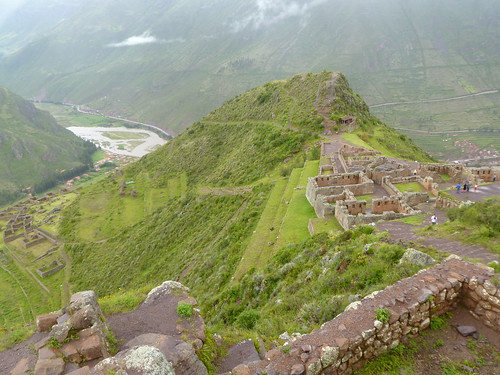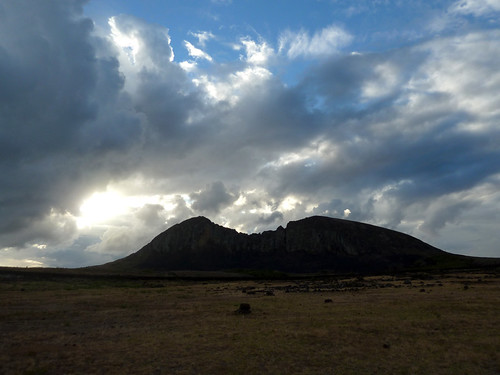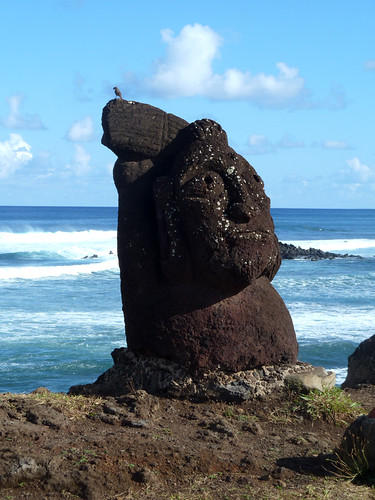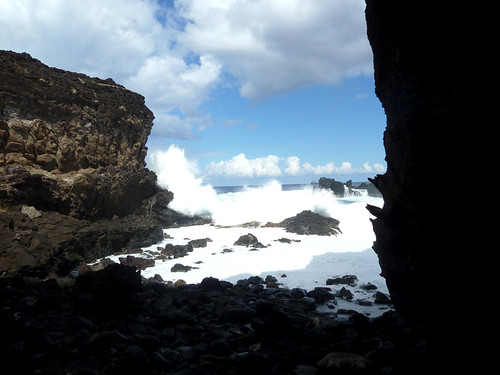So, from Lima I took the 16 hour bus down to Arequipa, a little ordeal all of its own, hung out for a day and then booked straight onto Colca Canyon 3 day tour with Land Adventures. Colca Canyon is supposed to be the second deepest canyon in the world after it´s neighbour Cotahuasi, and more than twice as deep as the Grand Canyon.
I was whisked into a bus with a bunch of other trekkers at 3am and then driven for 5 hours in the dark on bendy swervy roads up into the mountains, eventually reaching the Cruz del Condor (condor lookout point) at around 9am. Sadly there was cloud, so no condors could be sighted...Me and my trek buddies, Jane and Minh from Washinton DC, and our guide, Roy, continued on to breakfast and the start of the trail.
At 3400m,the view into Colca Canyon is breathtaking. Literally. The oxygen at this height is something like two thirds of what you might get at sea level,so even inhaling until your lungs press against your ribcage can leave you with not enough air. I was glad to start the trek downhill into the canyon as fast as possible. My trekking buddies and I zig zagged our way down vertiginous paths for most of the morning in the sunshine. On the way down we did manage to spot a few condors gliding sharklike through the canyon, predatory and extremely fast. An adult condor has a wing span of 3m, so even at a considerable distance they´re a formidable looking creature in the wild. Although there was plenty along the trail to distract us, the largest amount of time was spent keeping our eyes on the ground as the trail was steep and often covered in a loose skree that occasionally slid right out from under foot. Near vertical drops of a couple of thousand metres to one side do wonders for concentration, and I had no desire to wind up as condor fodder or go for an unplanned swim in the rushing white river waters that carved down through the bottom of the canyon.
At any rate, we eventually reached the river, much to my personal relief, because there was far less slippage climbing back up the other side after crossing the river. By now it was raining and we climbed up the canyon again for around 2 hours to reach our destination for the night - a little village perched around a quarter of the way up into the canyon wall.
To get there we had to negotiate perilous little paths well off the tourist track (most tour companies make camp down in the canyon floor in an oasis but our tour company is trying to spread the benefits of tourism to more remote villages). Along the route there were many places where the rain softened ground was cracked and ready to drop away. Also, in many parts boulders the size of cows had ploughed a gully into the canyon wall from high above the path into the river below, leaving, in some places, a foothold barely 10cm wide with the cliffs dropping away sheer from the path to one side. Nerves were inevitably a little frayed upon reaching our hostel. The place itself was rustic as expected, however I hadn´t really accounted for the heavy rain which had soaked through a full length waterproof poncho and an outdoors weather tight jacket to boot to soak me and the contents of my backpack thoroughly.
We all went and changed into slightly less wet clothes, and, in the absence of electricity, took a pack of cards and a candle into a little room while we waited for dinner. Now, I don´t know about anyone else in this world, but tired, sweaty, soaked to the skin, cold and with nerves well stretched by the treacherous paths and sat in a dark room, one of the last things I wanted to hear our guide exclaim from a dimly lit corner was: "Oh look! A snake!" swiftly followed by "Aha! A bigger one!".
He then proceeded to materialise two large open topped jars into the amber glow of the candle before our noses, each containing a thickly coiled snake. Me: "Oh. Great. Yeah, um, I don´t really like it though." He was attempting to give us some explanation about snakes and alcohol which I didn´t listen to as I was busy shuffling along the bench away from the unfortunate creatures.
Miraculously, at this moment dinner was called across the courtyard and we all trooped out of the Miniature Museum of Horrors into the pouring rain in order to get to the kitchen, where, mercifully, the dinner was both hot and delicious, consisting of a vegetable soup and a large plate of stirfried alpaca meat and vegetables and rice.
Dinner done, we were all crashed out and it was out into the rain again in order to reach the bedrooms, which alough packed with blankets, were cold and a little damp, and with hair still wet all there was to do was pile on layers and hope for the best.
At this point the altitude finally hits me. Having been fine all day, right from the top of the canyon, I suddenly find that everytime I close my eyes the bed, the room, the whole world is whirled away into the black void. I am unable to prevent this happening for the whole night, which, having gone to bed in the dark at 8pm, is a really long time to lie awake.
In the morning we get pancakes with caramel and bananas, a small comfort for a night of endless spinning, and soon enough we have to set off, unshowered or even washed at all because the heavy rains have ironically broken the villages water supply. I establish that the path leads straight on down to the oasis where we are headed for lunch and set off ahead of everyone because at this point I´m feeling really bad and just want to get to lower altitude and take a shower, but only 20 minutes in I come across another section of path that has been boulder ploughed, leaving only a steep loose skree slope to tread on at one point. I had handled these alright the day before but, today, with the world spinning and falling perpetually downwards around me, I just can´t cross it and have to sit low on the path and wait for the others to catch up with me 30 minutes later. On the trail down our guide distracts us by cutting off parts of cacti which turn out to be strange spiny fruits and giving them to us to eat. We eventually all make it down to the oasis together, where a cold shower, food and a swimming pool awaits.
It´s a brief respite, because we all know that after lunch we have to face the climb back out of the canyon, which is something like 3400 vertical metres of giant uneven stairs with little loose rocks to slide on. Jane opted to take a mule back to the top for an extra 60 Soles, and Minh purchased a back-up mule in case he needed it further on, but I was sure I didn´t want to perch on top of another four legged creature on those paths, no matter how sure footed and reliable they might be. Plus, I also wanted to be able to say I have walked out of one of the deepest canyons in the world.
Roy, Minh and I started up the trail well ahead of Jane, who was waiting for her mule in the sunny oasis. She passed us later, just after the halfway point, looking very happy and relaxed while we sweated and gasped the higher we climbed.
Then the rain set in and I was determined to get as far up the canyon as possible before it got very heavy so we set a fast pace for the first part. The last third or so of the climb became very difficult however, and I needed to break every couple of turns in the path because the higher we climbed the less oxygen there was, so cruelly we had to suffer the double pain of tired muscles and lack of air.
Now, if you´re climbing a mountain and the altituide starts to hurt you, you just turn around and go down without reaching the summit. But if you´re clambering out of a canyon and the only road out is at the top... you pretty much just have to make it.
Which we did. In 2 hours and 50 minutes. Not a bad time as the usual times are supposed to range between 3 and 4 hours to climb all the way out of the canyon.
So. That was it. I did it. I´m glad I did it. I´m really glad it´s over.
I had one more night´s sleep in damp clothes and damp hair in a freezing cold hostel at the top of the canyon and the next day we took pictures with llamas and alpacas and all the usual tourist stuff. Job done.
Sadly there are none of my own photographs to accompany this entry so I´m hoping to link to some of Jane and Minh´s phtographs when they upload them. They kindly took pics of me with the animals and at the top of the canyon too, so you should get to see a picture of me looking like I dragged myself out of hell in the drenching rain. Yay!































































